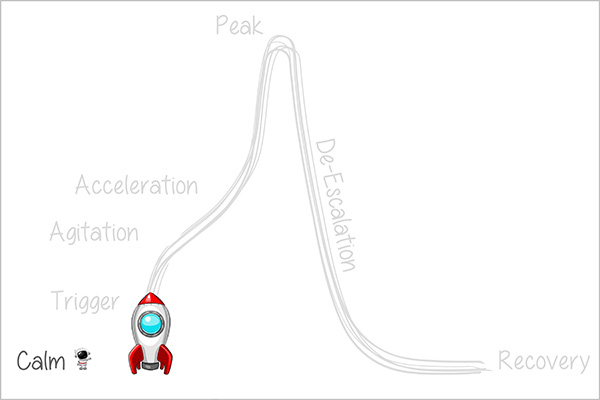How can educators recognize and intervene when student behavior is escalating?
Page 3: Calm
 The first phase of the acting-out cycle is the Calm Phase. In a successful and well-managed classroom, most students will stay in the Calm Phase a majority of the time. In it, students behave in ways that support a positive and productive classroom environment and are most responsive to instruction.
The first phase of the acting-out cycle is the Calm Phase. In a successful and well-managed classroom, most students will stay in the Calm Phase a majority of the time. In it, students behave in ways that support a positive and productive classroom environment and are most responsive to instruction.
What a Student Looks Like
In the Calm Phase, the student is on-task and follows classroom rules and expectations. Generally speaking, a student’s behavior can be described as:
- Compliant and cooperative
- Responsive to the teacher’s directions and praise
- Receptive to working with classmates
- On-task and academically engaged
In this video, note the behaviors that Nora displays during the Calm Phase (time: 1:30).
Transcript: Calm Phase
Teacher: All right friends, you’ve had time to check your homework. What questions do you have?
Teacher: Yes, Jordan.
Jordan: Can you show me how you solved number three?
Teacher: Number three, sure. Let’s see, we have 40 times three. Remember, we always start multiplying with the digit in the ones place. So we have three times zero. What is three times zero?
Jordan: Three times zero equals zero.
Teacher: Yes. Three times zero equals zero. And where do we write the zero in our answer?
Jordan: In the ones place.
Teacher: Nice.
[ Johanna Staubitz commentary ]
What we see here of Nora in the Calm Phase is that she is oriented toward the teacher and the instruction that’s happening. She has her materials out on her desk. She seems to be using them appropriately for the most part and has her eyes forward as well. So it could be that a student’s body is oriented the right way, but they’re looking away and that could be a sign that they’re not calm. But Nora appears to be alert and engaged, based on this body language. And it’s important for Mr. Santini to notice that because we have already established (as you heard in the Challenge scenario) that Nora has a hard time when her peers are asking questions. So that’s going on here and so a teacher should be, Mr. Santini should be, looking and saying, “Oh, this is a challenging situation for Nora. Okay. Her actions show me that she’s calm right now versus demonstrating signs of a trigger.”
Strategies To Implement
One of the best ways to prevent challenging behaviors from occurring is to keep students in the Calm Phase. The table below outlines some strategies and tips to help accomplish that goal.
| Strategies | Tips |
|
Explicitly teach classroom rules and procedures. |
For more information on teaching classroom rules and procedures, review the following IRIS Module: |
|
Build (and maintain) relationships with students. |
Note: Students who have a positive relationship with their teacher are much more likely to respond positively when the teacher attempts to de-escalate behaviors. Similarly, when teachers know their students, they are much more likely to understand what strategies will work best in each phase of the acting-out cycle. |
|
Create engaging lessons linked to state or district standards. |
Keep in Mind: Academics and behavior are interlinked: When students are on-task and engaged in classroom activities, they are much less likely to engage in challenging behaviors. |
|
Focus on social and emotional skills. |
Note: If a school does not have a social-emotional learning (SEL) program, teachers can incorporate social and emotional skill building into daily class instruction and model these skills while interacting with students. x
social-emotional learning A process through which students gain the knowledge and skills to develop self-control and self-awareness in order to manage emotions, build healthy identities, and maintain positive relationships. |
|
Use low-intensity strategies to support student engagement. |
x
low-intensity strategies Easy-to-implement practices that require minimal time and preparation.
x
noncontingent attention Positive reinforcement given to a student that is not based on classroom behavior or performance. This can include smiling, thumbs up, greetings, positive comments, and non-academic conversations. x
contingent attention Positive reinforcement given to a student based on classroom behavior or performance. This can include verbal encouragement, behavior-specific praise, and positive notes. x
behavior-specific praise A positive, declarative statement directed toward a child or group of children that describes a desirable behavior in specific, observable, and measurable terms; also referred to as descriptive praise. For example, “Table 4, thank you for bringing your notebooks to class today.” |
|
Arrange the classroom to help establish a learning environment that facilitates student growth. |
To learn more about effectively organizing the classroom, view this IRIS Case Study: |
Kathleen Lane explains more about when and how a teacher should use attention to maintain a calm classroom. Next, Dr. Gloria Campbell-Whatley explains why it’s important to consider students’ cultures and backgrounds to maintain a high level of engagement during instruction. Finally, Harold Holmes discusses the importance of creating a structured classroom to keep students in the Calm Phase.

Kathleen Lane, PhD, BCBA-D
Professor
Department of Special Education
Associate Vice Chancellor for Research
University of Kansas
(time: 1:26)

Gloria Campbell-Whatley, Ed.D.
Professor, Special Education
University of North Carolina, Charlotte
(time: 3:08)
Transcript: Kathleen Lane, PhD, BCBA-D
In terms of the calm stage, I would like to suggest that the very best behavior management plan is a good lesson plan. And really, it’s about being attentive during this time. It’s providing students with both contingent and noncontingent attention. Contingent attention is when a student does something desirable, like when they complete their work or ask for help in a respectful way or do something nice for another student. We are taught as teachers to recognize that and say something very specific like, “I appreciated the fact that you shared your eraser with Johnny because he had a problem that he had to fix, and he didn’t have an eraser.” Or “That was really nice of you to help Cheryl clean up after she spilled her tray in the cafeteria.” But there’s also, during this calm phase, another way of maintaining that just by offering students non-contingent attention. And that, just by virtue of being in your classroom, there’s going to be some dialogue or interaction between a teacher and a student. And whether you greet them at the door, it doesn’t have to be a compliment. It can be as simple as something like, “Hey, you know, I missed you yesterday,” or “What’s going on? How’s your family?” Or “Did you have a chance to go to the game last night? I heard we had a really challenging second half.” Just something so they recognize that you’re a human being and you value them as a human being. And building positive, productive student-teacher relationships is really helpful to building calm, supportive, instructionally focused classroom settings.
Transcript: Gloria Campbell-Whatley
The Calm Phase would be your instructional kind of situation. And during the Calm Phase, many teachers hold traditional beliefs that “I’m teaching this method that works.” And so, because this method works, then I can just teach it, and everybody will get it. But that makes you blind to the different nuances in the classroom. So teachers must understand how beliefs and values in the lives of students may be different. Many times, we don’t look at ourselves and look at our privilege or socioeconomic status. So you’ve got to do some self-reflecting and figure out how you can differentiate instruction—not just according to academic levels, but the differences that you have in your classroom. You can get familiar with the culture when you do circles. You can give a topic that’s open-ended and students can write, and then they can get up and talk about what’s going on in the community or at home and you begin to understand the culture and the other students begin to understand the culture. This is very important to instruction; you have to learn to see through the eyes of another culture. You can present your assignments in different ways, looking at language, speech… you have to create a number of ways for students to show they know something. They may be able to do a skit, or poetry, or something else. It’s also important to have a classroom arrangement that facilitates high engagement. Students are already seated so that they can work together, even though they may be creating a lot of noise; [laughs] noise goes with that productive working. And that may be something that the teacher may not be used to. Teachers will need to reflect, “Who is engaged in the lessons and who’s not engaged in the lessons.” You want high engagement from all of the students. You’ve got to have multiple means of expression, multiple means of engagement, and multiple means of representation.
There is a method called positive framing [laughs] that you can use to make sure that you talk to the students in a very positive way, and it’s celebratory. With positive framing, you don’t focus on what they did wrong, you focus on what they did correct, and you make sure that you engage them in a very exciting way. It helps students’ behavior, [laughs] in that the next time you want this high level of engagement they will be ready for that, because they know that they’re going to be rewarded and rewarded positively. There’s not a deficit view.
Transcript: Harold Holmes
I think structure is definitely the biggest thing in a gen ed classroom. The more efficient you’re able to get these kids in and out of activities, the better. And when you’re dealing with a group that size, you have to involve as many students as possible. Don’t feel like you’re the only one that has to make things run in your classroom. It could be something as simple as make sure you have sharpened pencils available. That’s a huge thing. You’re trying to go through an activity. You got kids rifling through their desks, papers falling out. They’re trying to find pencils. These are little, small things, but over time it can wreck a lesson. If you have two or three kids that make sure there’s sharpened pencils available for everyone. Kids want to help. So, if you involve them in that, they increase their feeling of being vested and involved and a part of the classroom. Not only would that help with removing antecedents, but it’ll make them less likely to engage in the challenging behaviors because they feel like this is their home. I think the more you try to control those possible antecedents in a gen ed classroom, the better. Having that structure in place, having routines tight and in place. Something as simple as lining up for lunch; I’ll definitely would have at this point line order established by last name. You will have spots in a room for everyone to stand. Sometimes you will mark that on the floor with tape. You may do that or you may have, depending on a grade level, you may post the names on the door, in line order. You may have some system in place to where these kids know every day this is where I’m supposed to be, and what I’m supposed to do. You’ve got to have a system in place, but it has to be done consistently and it has to be to the point where it’s not taking much of your time or even creates frustration for everyone trying to do this every day. You got to know what something is not working, too, and that should be found out early.
Activity
Kai’s behavior in the Calm Phase is illustrated in the video below. After reviewing, answer the following questions. You may type your answers in the field below the video. However, this field is provided for reflection purposes only; your answers will not be available for download or printing.
- What behaviors does Kai exhibit that indicate that he is in the Calm Phase?
- What does Mr. Santini do to keep Kai engaged and in the Calm Phase?
Transcript: Calm Phase
Teacher: Alrighty friends, we are going to read a passage about the landmarks in Tennessee. Would someone like to volunteer to pass out the readings?
Teacher: Thank you, Kayla.
Teacher: Colin, nice job sitting quietly.
Teacher: Kai, excellent job showing me you’re ready for reading by sitting quietly.
Kai: Thanks.
Now that you’ve had a chance to reflect, listen to Johanna Staubitz’s feedback (time: 0:59).

Johanna Staubitz, PhD, BCBA-D
Assistant Professor
Department of Special Education
Vanderbilt University
Transcript: Johanna Staubitz
We can tell that Kai is calm currently because he is oriented toward the teacher and other instructional materials. His hands are kind of up in view, on the desk, and not really actively engaging with anything other than he’s holding his pencil. But he’s holding it still, and he looks ready to learn here. And Mr. Santini is doing several things to keep Kai in this condition, which include actively supervising. He’s moving around, and while he’s doing that, he’s delivering behavior-specific praise. First, he does that to other students. That can help everybody to hear another student be praised for sitting nicely. Maybe they all start to do it because maybe there will be some praise for them. And then he also praises Kai specifically for showing that he’s ready for reading instruction, and he knows to do this because he knows Kai, he has a relationship with him. He knows that reading instruction can be a challenge. And, so he wants to really get in early and reinforce that Kai is showing he’s ready, even though it’s a challenging subject.
